Importance of Language and Literacy for Early Childhood Education
VerifiedAdded on 2020/05/16
|13
|3651
|520
Report
AI Summary
This report, focusing on language and literacy in early childhood, delves into the critical importance of language development and literacy skills. It begins by establishing the foundational role of language in human communication and explores various theories of language acquisition, including behaviorist, nativist, and cognitivist perspectives. The report then presents a literature review, examining articles and research on the emotional bonds between teachers and students, the impact of early adolescence on brain development, the role of reading activities in literacy, and the influence of reading habits on literary standing. An interview with a preschool teacher provides insights into classroom reading activities, assessment methods, and the effects of reading on language and literacy development. The report analyzes two key reading activities: reading paragraphs aloud and explaining complex paragraphs, highlighting their impact on developing reading enthusiasm, cognitive abilities, text analysis skills, and creative thinking. Overall, the report emphasizes the importance of fostering language and literacy skills from an early age through interactive classroom practices and comprehensive assessment methods.
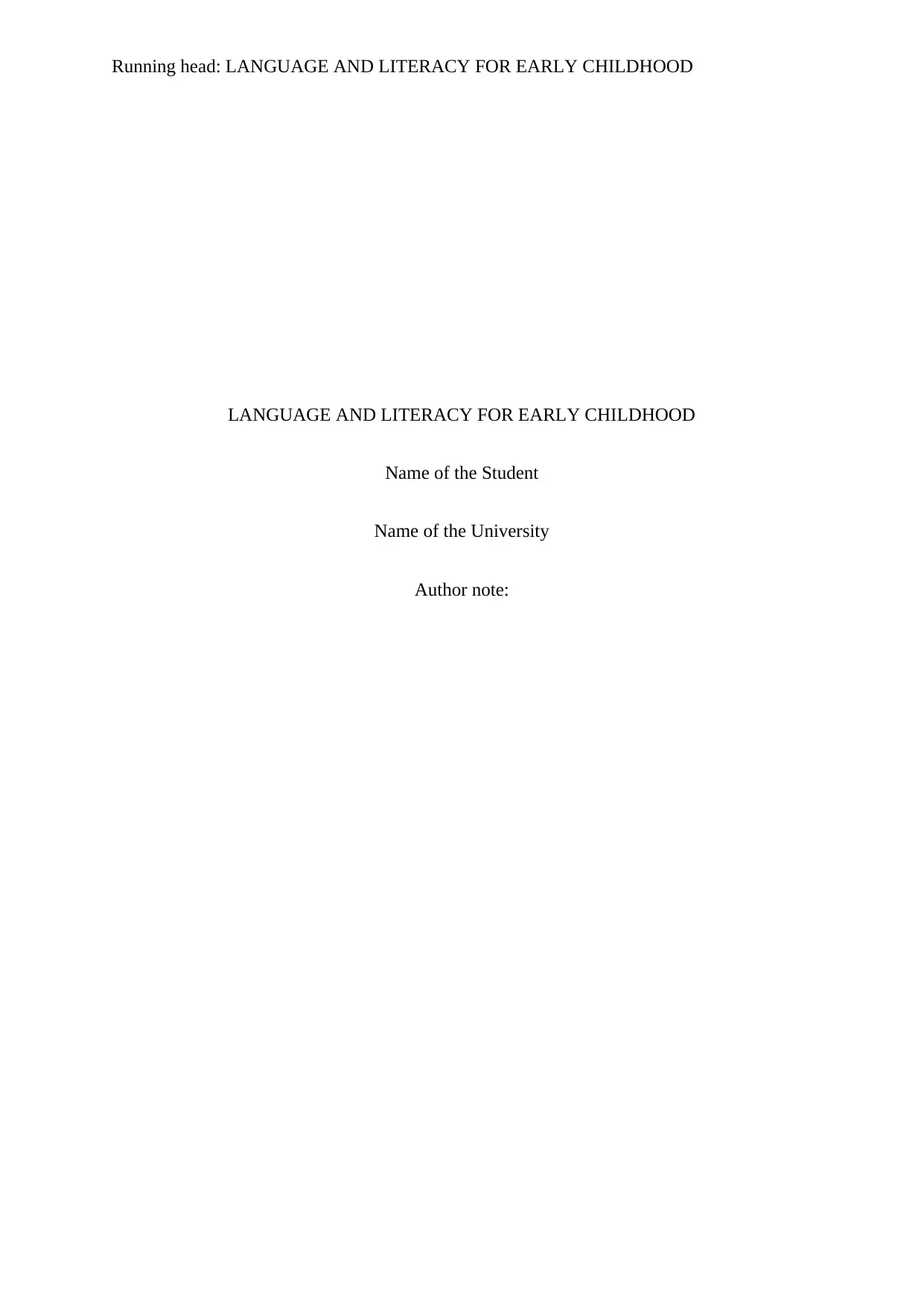
Running head: LANGUAGE AND LITERACY FOR EARLY CHILDHOOD
LANGUAGE AND LITERACY FOR EARLY CHILDHOOD
Name of the Student
Name of the University
Author note:
LANGUAGE AND LITERACY FOR EARLY CHILDHOOD
Name of the Student
Name of the University
Author note:
Paraphrase This Document
Need a fresh take? Get an instant paraphrase of this document with our AI Paraphraser
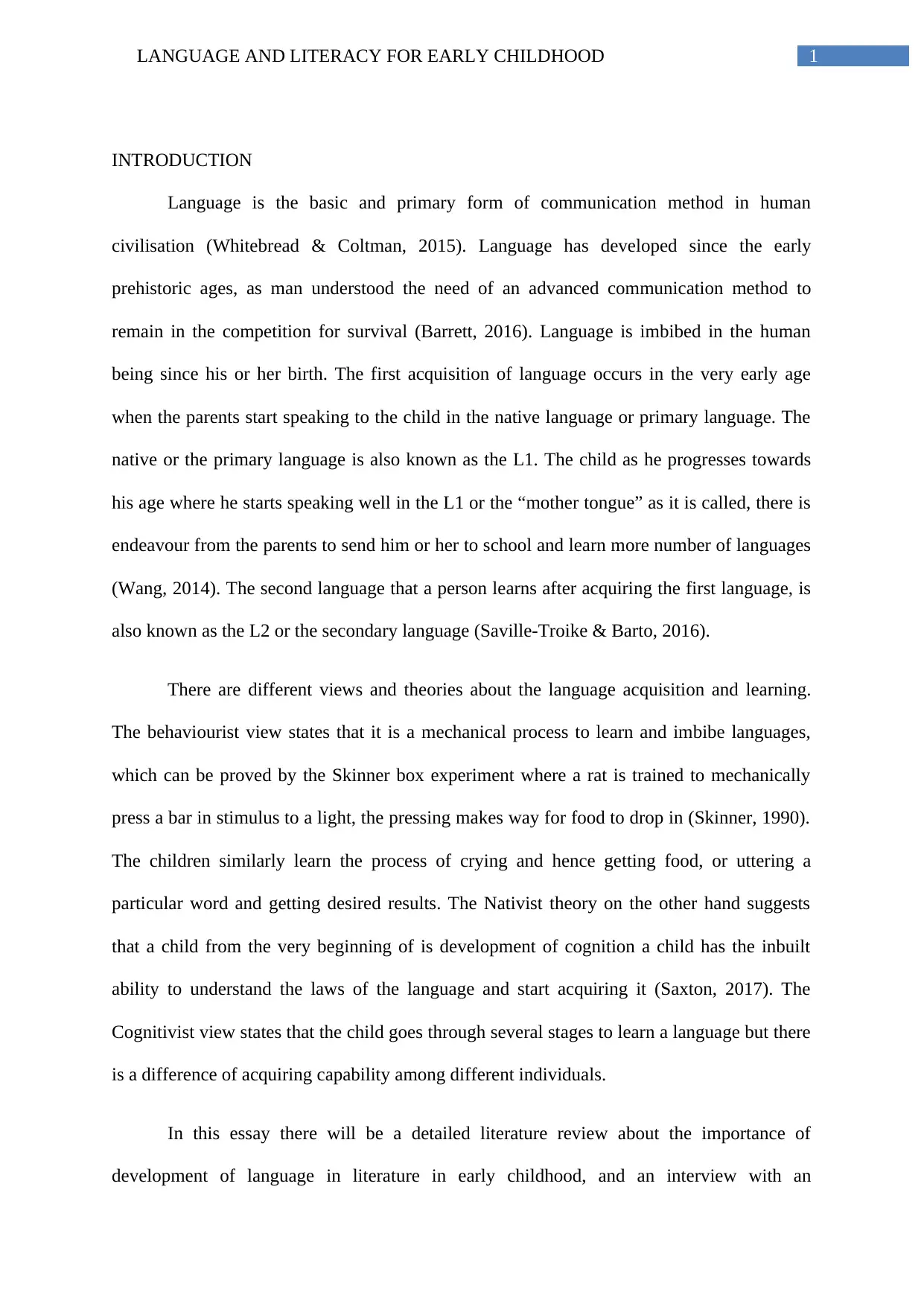
1LANGUAGE AND LITERACY FOR EARLY CHILDHOOD
INTRODUCTION
Language is the basic and primary form of communication method in human
civilisation (Whitebread & Coltman, 2015). Language has developed since the early
prehistoric ages, as man understood the need of an advanced communication method to
remain in the competition for survival (Barrett, 2016). Language is imbibed in the human
being since his or her birth. The first acquisition of language occurs in the very early age
when the parents start speaking to the child in the native language or primary language. The
native or the primary language is also known as the L1. The child as he progresses towards
his age where he starts speaking well in the L1 or the “mother tongue” as it is called, there is
endeavour from the parents to send him or her to school and learn more number of languages
(Wang, 2014). The second language that a person learns after acquiring the first language, is
also known as the L2 or the secondary language (Saville-Troike & Barto, 2016).
There are different views and theories about the language acquisition and learning.
The behaviourist view states that it is a mechanical process to learn and imbibe languages,
which can be proved by the Skinner box experiment where a rat is trained to mechanically
press a bar in stimulus to a light, the pressing makes way for food to drop in (Skinner, 1990).
The children similarly learn the process of crying and hence getting food, or uttering a
particular word and getting desired results. The Nativist theory on the other hand suggests
that a child from the very beginning of is development of cognition a child has the inbuilt
ability to understand the laws of the language and start acquiring it (Saxton, 2017). The
Cognitivist view states that the child goes through several stages to learn a language but there
is a difference of acquiring capability among different individuals.
In this essay there will be a detailed literature review about the importance of
development of language in literature in early childhood, and an interview with an
INTRODUCTION
Language is the basic and primary form of communication method in human
civilisation (Whitebread & Coltman, 2015). Language has developed since the early
prehistoric ages, as man understood the need of an advanced communication method to
remain in the competition for survival (Barrett, 2016). Language is imbibed in the human
being since his or her birth. The first acquisition of language occurs in the very early age
when the parents start speaking to the child in the native language or primary language. The
native or the primary language is also known as the L1. The child as he progresses towards
his age where he starts speaking well in the L1 or the “mother tongue” as it is called, there is
endeavour from the parents to send him or her to school and learn more number of languages
(Wang, 2014). The second language that a person learns after acquiring the first language, is
also known as the L2 or the secondary language (Saville-Troike & Barto, 2016).
There are different views and theories about the language acquisition and learning.
The behaviourist view states that it is a mechanical process to learn and imbibe languages,
which can be proved by the Skinner box experiment where a rat is trained to mechanically
press a bar in stimulus to a light, the pressing makes way for food to drop in (Skinner, 1990).
The children similarly learn the process of crying and hence getting food, or uttering a
particular word and getting desired results. The Nativist theory on the other hand suggests
that a child from the very beginning of is development of cognition a child has the inbuilt
ability to understand the laws of the language and start acquiring it (Saxton, 2017). The
Cognitivist view states that the child goes through several stages to learn a language but there
is a difference of acquiring capability among different individuals.
In this essay there will be a detailed literature review about the importance of
development of language in literature in early childhood, and an interview with an

2LANGUAGE AND LITERACY FOR EARLY CHILDHOOD
experienced teacher about the same topic, which will throw light on different aspects
including reading activities in classroom, methods used to train students and the strategies.
DISCUSSION
The literature review of different related journals, articles and researches leads
to clear comprehension and understanding of the subject. In the article “Language
development in the early school years: The importance of close relationships with
teachers” the authors have pointed out that an emotional bond between the teacher and the
students is necessary for an effective development of language skills among the students
(Spilt, Koomen, & Harrison, 2015). The students who receive an emotional support tend to
reciprocate by learning quicker and in a better way. It is a fact that students who feel like
home in their schools are much more interested in going to the schools and participating in
learning activities. The students who feel secluded would naturally develop low interests in
learning.
In the article “Adolescence as a sensitive period of brain development” the authors
point out how learning is most effective in the early adolescence as this is the most crucial
stage in the growth of brain, and the cognitive abilities of the children increase considerably
(Fuhrmann, Knoll & Blakemore, 2015). The brain’s activity of acquiring new knowledge and
making oneself compatible with the acquired knowledge starts from the very childhood,
hence it is advisable for the parents and the teachers to imbibe language training into the
children at an early age.
Rodríguez (2017) in his article “Perception of Pragmalinguistic Knowledge in
Primary Spanish Teacher Training Students of English as a Foreign Language” has stated
what is the role of reading activity in acquiring a second language. Literacy not only
comprises of the native language of the person, but the other languages that a person learns
experienced teacher about the same topic, which will throw light on different aspects
including reading activities in classroom, methods used to train students and the strategies.
DISCUSSION
The literature review of different related journals, articles and researches leads
to clear comprehension and understanding of the subject. In the article “Language
development in the early school years: The importance of close relationships with
teachers” the authors have pointed out that an emotional bond between the teacher and the
students is necessary for an effective development of language skills among the students
(Spilt, Koomen, & Harrison, 2015). The students who receive an emotional support tend to
reciprocate by learning quicker and in a better way. It is a fact that students who feel like
home in their schools are much more interested in going to the schools and participating in
learning activities. The students who feel secluded would naturally develop low interests in
learning.
In the article “Adolescence as a sensitive period of brain development” the authors
point out how learning is most effective in the early adolescence as this is the most crucial
stage in the growth of brain, and the cognitive abilities of the children increase considerably
(Fuhrmann, Knoll & Blakemore, 2015). The brain’s activity of acquiring new knowledge and
making oneself compatible with the acquired knowledge starts from the very childhood,
hence it is advisable for the parents and the teachers to imbibe language training into the
children at an early age.
Rodríguez (2017) in his article “Perception of Pragmalinguistic Knowledge in
Primary Spanish Teacher Training Students of English as a Foreign Language” has stated
what is the role of reading activity in acquiring a second language. Literacy not only
comprises of the native language of the person, but the other languages that a person learns
⊘ This is a preview!⊘
Do you want full access?
Subscribe today to unlock all pages.

Trusted by 1+ million students worldwide
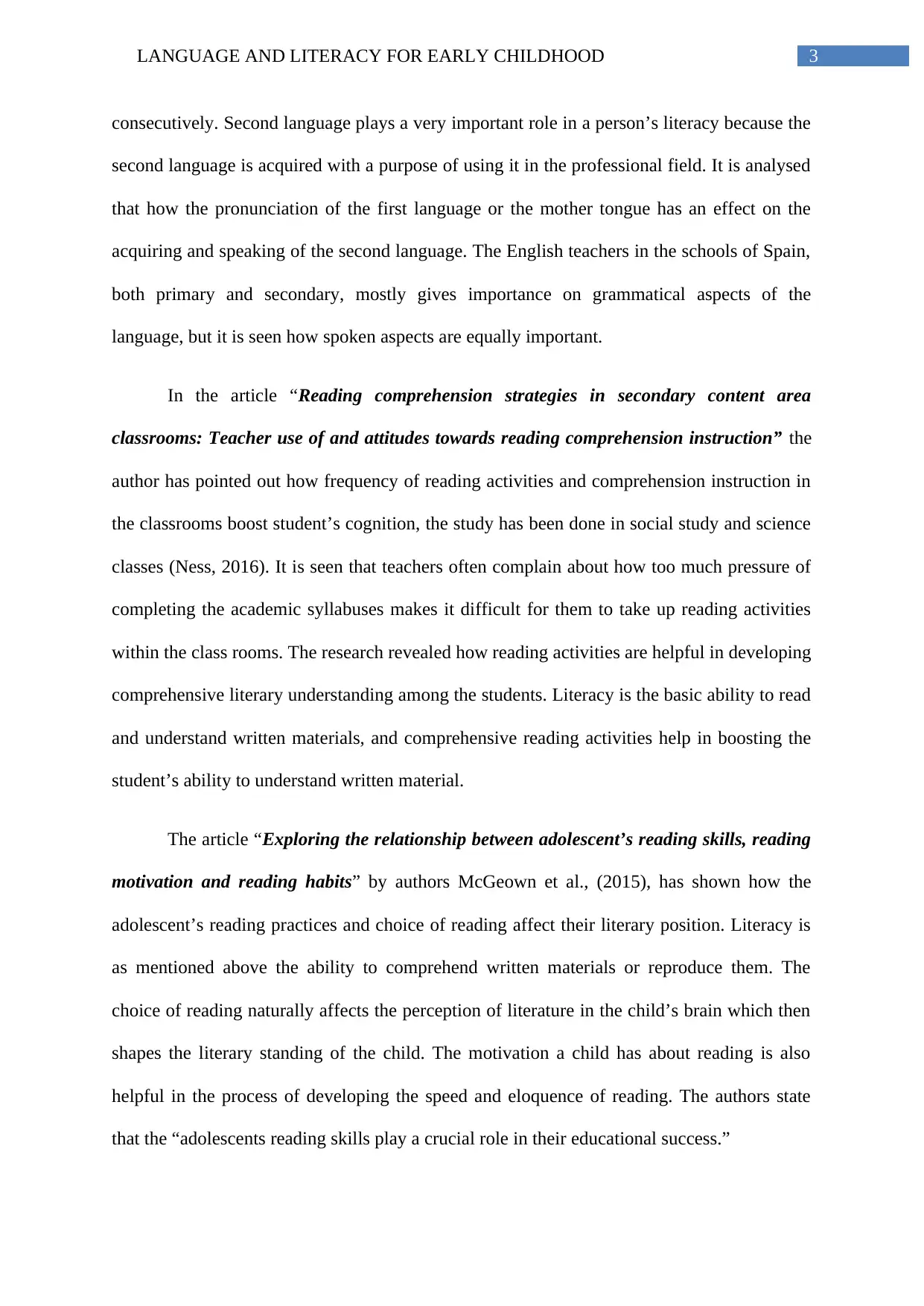
3LANGUAGE AND LITERACY FOR EARLY CHILDHOOD
consecutively. Second language plays a very important role in a person’s literacy because the
second language is acquired with a purpose of using it in the professional field. It is analysed
that how the pronunciation of the first language or the mother tongue has an effect on the
acquiring and speaking of the second language. The English teachers in the schools of Spain,
both primary and secondary, mostly gives importance on grammatical aspects of the
language, but it is seen how spoken aspects are equally important.
In the article “Reading comprehension strategies in secondary content area
classrooms: Teacher use of and attitudes towards reading comprehension instruction” the
author has pointed out how frequency of reading activities and comprehension instruction in
the classrooms boost student’s cognition, the study has been done in social study and science
classes (Ness, 2016). It is seen that teachers often complain about how too much pressure of
completing the academic syllabuses makes it difficult for them to take up reading activities
within the class rooms. The research revealed how reading activities are helpful in developing
comprehensive literary understanding among the students. Literacy is the basic ability to read
and understand written materials, and comprehensive reading activities help in boosting the
student’s ability to understand written material.
The article “Exploring the relationship between adolescent’s reading skills, reading
motivation and reading habits” by authors McGeown et al., (2015), has shown how the
adolescent’s reading practices and choice of reading affect their literary position. Literacy is
as mentioned above the ability to comprehend written materials or reproduce them. The
choice of reading naturally affects the perception of literature in the child’s brain which then
shapes the literary standing of the child. The motivation a child has about reading is also
helpful in the process of developing the speed and eloquence of reading. The authors state
that the “adolescents reading skills play a crucial role in their educational success.”
consecutively. Second language plays a very important role in a person’s literacy because the
second language is acquired with a purpose of using it in the professional field. It is analysed
that how the pronunciation of the first language or the mother tongue has an effect on the
acquiring and speaking of the second language. The English teachers in the schools of Spain,
both primary and secondary, mostly gives importance on grammatical aspects of the
language, but it is seen how spoken aspects are equally important.
In the article “Reading comprehension strategies in secondary content area
classrooms: Teacher use of and attitudes towards reading comprehension instruction” the
author has pointed out how frequency of reading activities and comprehension instruction in
the classrooms boost student’s cognition, the study has been done in social study and science
classes (Ness, 2016). It is seen that teachers often complain about how too much pressure of
completing the academic syllabuses makes it difficult for them to take up reading activities
within the class rooms. The research revealed how reading activities are helpful in developing
comprehensive literary understanding among the students. Literacy is the basic ability to read
and understand written materials, and comprehensive reading activities help in boosting the
student’s ability to understand written material.
The article “Exploring the relationship between adolescent’s reading skills, reading
motivation and reading habits” by authors McGeown et al., (2015), has shown how the
adolescent’s reading practices and choice of reading affect their literary position. Literacy is
as mentioned above the ability to comprehend written materials or reproduce them. The
choice of reading naturally affects the perception of literature in the child’s brain which then
shapes the literary standing of the child. The motivation a child has about reading is also
helpful in the process of developing the speed and eloquence of reading. The authors state
that the “adolescents reading skills play a crucial role in their educational success.”
Paraphrase This Document
Need a fresh take? Get an instant paraphrase of this document with our AI Paraphraser
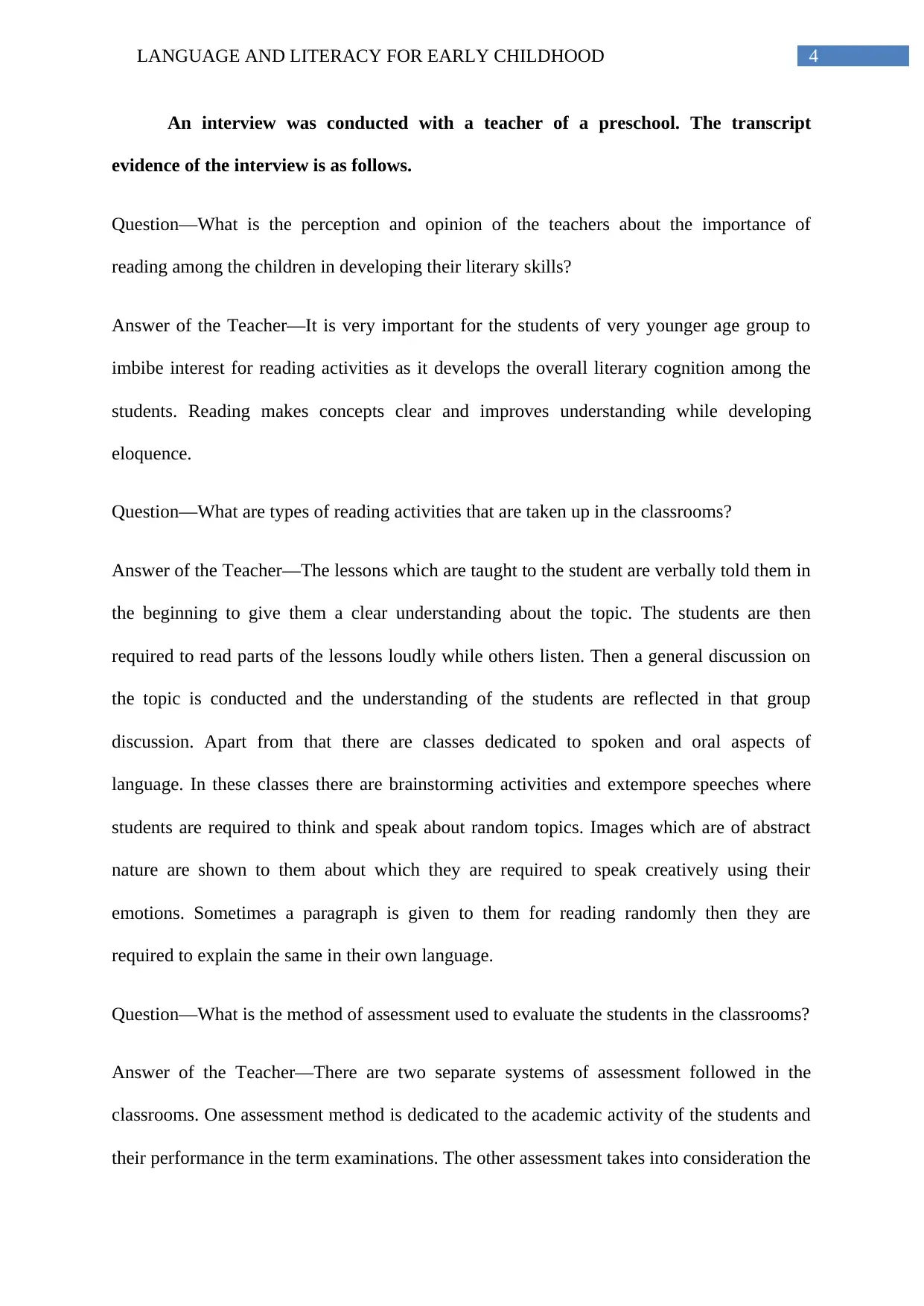
4LANGUAGE AND LITERACY FOR EARLY CHILDHOOD
An interview was conducted with a teacher of a preschool. The transcript
evidence of the interview is as follows.
Question—What is the perception and opinion of the teachers about the importance of
reading among the children in developing their literary skills?
Answer of the Teacher—It is very important for the students of very younger age group to
imbibe interest for reading activities as it develops the overall literary cognition among the
students. Reading makes concepts clear and improves understanding while developing
eloquence.
Question—What are types of reading activities that are taken up in the classrooms?
Answer of the Teacher—The lessons which are taught to the student are verbally told them in
the beginning to give them a clear understanding about the topic. The students are then
required to read parts of the lessons loudly while others listen. Then a general discussion on
the topic is conducted and the understanding of the students are reflected in that group
discussion. Apart from that there are classes dedicated to spoken and oral aspects of
language. In these classes there are brainstorming activities and extempore speeches where
students are required to think and speak about random topics. Images which are of abstract
nature are shown to them about which they are required to speak creatively using their
emotions. Sometimes a paragraph is given to them for reading randomly then they are
required to explain the same in their own language.
Question—What is the method of assessment used to evaluate the students in the classrooms?
Answer of the Teacher—There are two separate systems of assessment followed in the
classrooms. One assessment method is dedicated to the academic activity of the students and
their performance in the term examinations. The other assessment takes into consideration the
An interview was conducted with a teacher of a preschool. The transcript
evidence of the interview is as follows.
Question—What is the perception and opinion of the teachers about the importance of
reading among the children in developing their literary skills?
Answer of the Teacher—It is very important for the students of very younger age group to
imbibe interest for reading activities as it develops the overall literary cognition among the
students. Reading makes concepts clear and improves understanding while developing
eloquence.
Question—What are types of reading activities that are taken up in the classrooms?
Answer of the Teacher—The lessons which are taught to the student are verbally told them in
the beginning to give them a clear understanding about the topic. The students are then
required to read parts of the lessons loudly while others listen. Then a general discussion on
the topic is conducted and the understanding of the students are reflected in that group
discussion. Apart from that there are classes dedicated to spoken and oral aspects of
language. In these classes there are brainstorming activities and extempore speeches where
students are required to think and speak about random topics. Images which are of abstract
nature are shown to them about which they are required to speak creatively using their
emotions. Sometimes a paragraph is given to them for reading randomly then they are
required to explain the same in their own language.
Question—What is the method of assessment used to evaluate the students in the classrooms?
Answer of the Teacher—There are two separate systems of assessment followed in the
classrooms. One assessment method is dedicated to the academic activity of the students and
their performance in the term examinations. The other assessment takes into consideration the
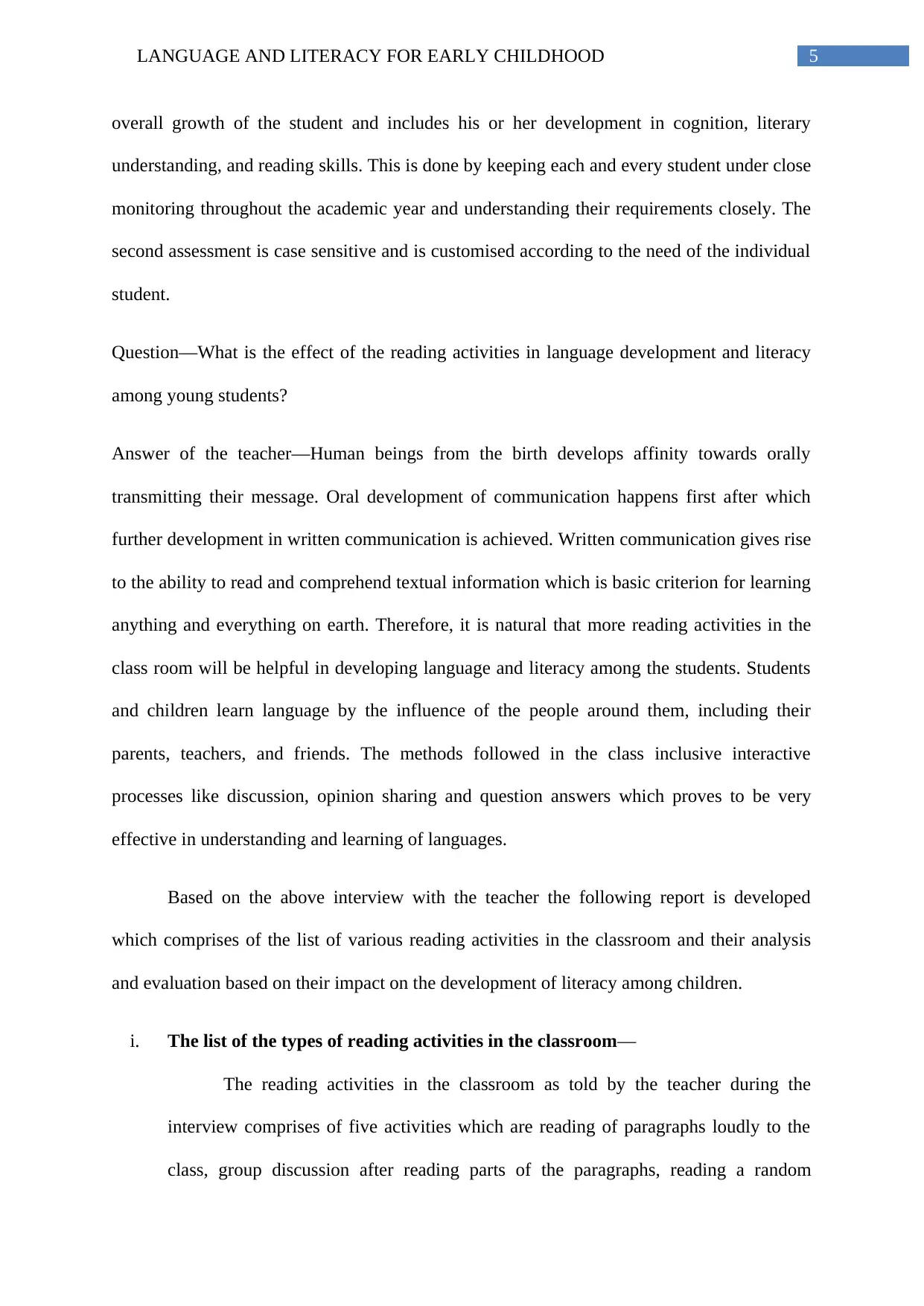
5LANGUAGE AND LITERACY FOR EARLY CHILDHOOD
overall growth of the student and includes his or her development in cognition, literary
understanding, and reading skills. This is done by keeping each and every student under close
monitoring throughout the academic year and understanding their requirements closely. The
second assessment is case sensitive and is customised according to the need of the individual
student.
Question—What is the effect of the reading activities in language development and literacy
among young students?
Answer of the teacher—Human beings from the birth develops affinity towards orally
transmitting their message. Oral development of communication happens first after which
further development in written communication is achieved. Written communication gives rise
to the ability to read and comprehend textual information which is basic criterion for learning
anything and everything on earth. Therefore, it is natural that more reading activities in the
class room will be helpful in developing language and literacy among the students. Students
and children learn language by the influence of the people around them, including their
parents, teachers, and friends. The methods followed in the class inclusive interactive
processes like discussion, opinion sharing and question answers which proves to be very
effective in understanding and learning of languages.
Based on the above interview with the teacher the following report is developed
which comprises of the list of various reading activities in the classroom and their analysis
and evaluation based on their impact on the development of literacy among children.
i. The list of the types of reading activities in the classroom—
The reading activities in the classroom as told by the teacher during the
interview comprises of five activities which are reading of paragraphs loudly to the
class, group discussion after reading parts of the paragraphs, reading a random
overall growth of the student and includes his or her development in cognition, literary
understanding, and reading skills. This is done by keeping each and every student under close
monitoring throughout the academic year and understanding their requirements closely. The
second assessment is case sensitive and is customised according to the need of the individual
student.
Question—What is the effect of the reading activities in language development and literacy
among young students?
Answer of the teacher—Human beings from the birth develops affinity towards orally
transmitting their message. Oral development of communication happens first after which
further development in written communication is achieved. Written communication gives rise
to the ability to read and comprehend textual information which is basic criterion for learning
anything and everything on earth. Therefore, it is natural that more reading activities in the
class room will be helpful in developing language and literacy among the students. Students
and children learn language by the influence of the people around them, including their
parents, teachers, and friends. The methods followed in the class inclusive interactive
processes like discussion, opinion sharing and question answers which proves to be very
effective in understanding and learning of languages.
Based on the above interview with the teacher the following report is developed
which comprises of the list of various reading activities in the classroom and their analysis
and evaluation based on their impact on the development of literacy among children.
i. The list of the types of reading activities in the classroom—
The reading activities in the classroom as told by the teacher during the
interview comprises of five activities which are reading of paragraphs loudly to the
class, group discussion after reading parts of the paragraphs, reading a random
⊘ This is a preview!⊘
Do you want full access?
Subscribe today to unlock all pages.

Trusted by 1+ million students worldwide
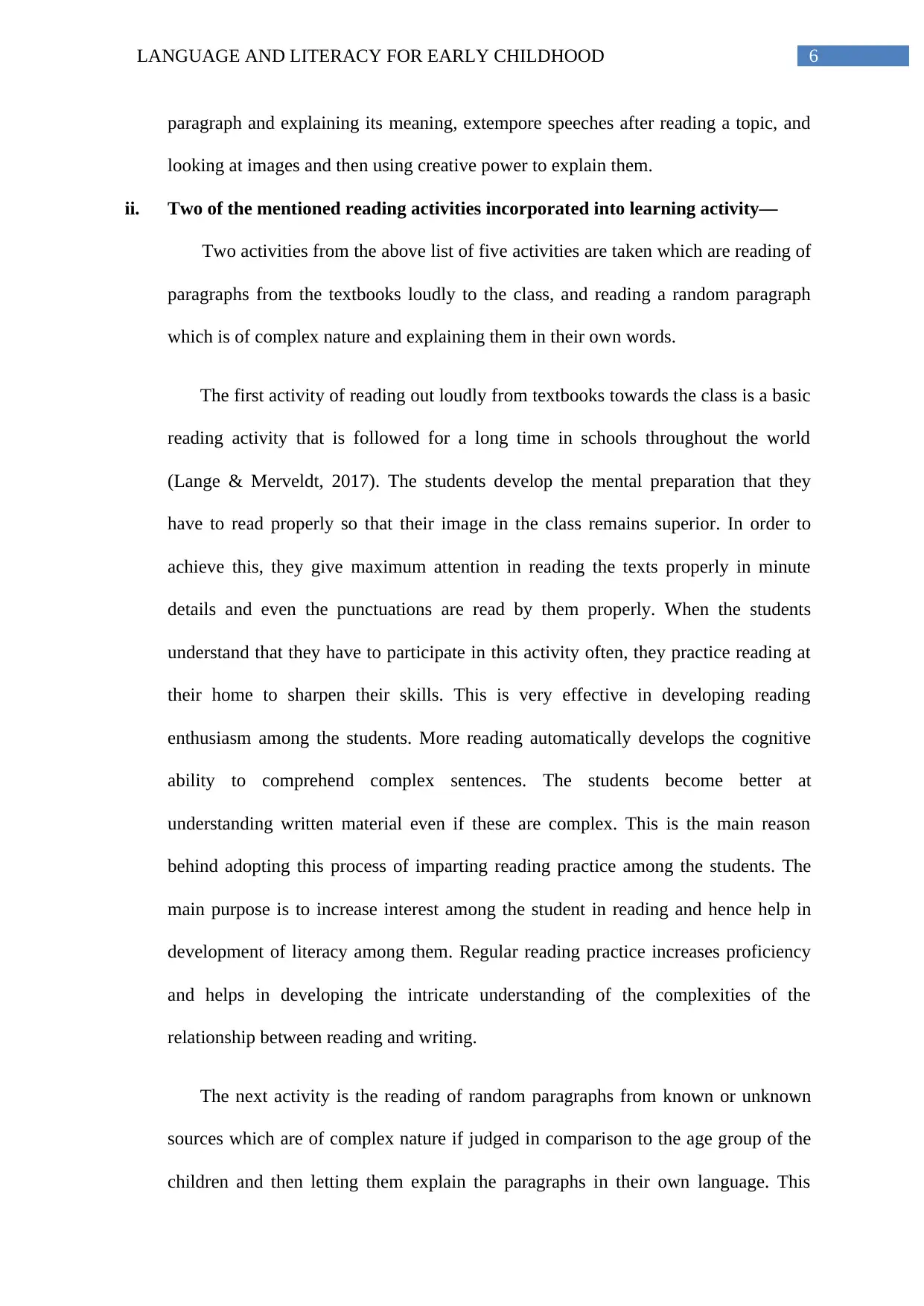
6LANGUAGE AND LITERACY FOR EARLY CHILDHOOD
paragraph and explaining its meaning, extempore speeches after reading a topic, and
looking at images and then using creative power to explain them.
ii. Two of the mentioned reading activities incorporated into learning activity—
Two activities from the above list of five activities are taken which are reading of
paragraphs from the textbooks loudly to the class, and reading a random paragraph
which is of complex nature and explaining them in their own words.
The first activity of reading out loudly from textbooks towards the class is a basic
reading activity that is followed for a long time in schools throughout the world
(Lange & Merveldt, 2017). The students develop the mental preparation that they
have to read properly so that their image in the class remains superior. In order to
achieve this, they give maximum attention in reading the texts properly in minute
details and even the punctuations are read by them properly. When the students
understand that they have to participate in this activity often, they practice reading at
their home to sharpen their skills. This is very effective in developing reading
enthusiasm among the students. More reading automatically develops the cognitive
ability to comprehend complex sentences. The students become better at
understanding written material even if these are complex. This is the main reason
behind adopting this process of imparting reading practice among the students. The
main purpose is to increase interest among the student in reading and hence help in
development of literacy among them. Regular reading practice increases proficiency
and helps in developing the intricate understanding of the complexities of the
relationship between reading and writing.
The next activity is the reading of random paragraphs from known or unknown
sources which are of complex nature if judged in comparison to the age group of the
children and then letting them explain the paragraphs in their own language. This
paragraph and explaining its meaning, extempore speeches after reading a topic, and
looking at images and then using creative power to explain them.
ii. Two of the mentioned reading activities incorporated into learning activity—
Two activities from the above list of five activities are taken which are reading of
paragraphs from the textbooks loudly to the class, and reading a random paragraph
which is of complex nature and explaining them in their own words.
The first activity of reading out loudly from textbooks towards the class is a basic
reading activity that is followed for a long time in schools throughout the world
(Lange & Merveldt, 2017). The students develop the mental preparation that they
have to read properly so that their image in the class remains superior. In order to
achieve this, they give maximum attention in reading the texts properly in minute
details and even the punctuations are read by them properly. When the students
understand that they have to participate in this activity often, they practice reading at
their home to sharpen their skills. This is very effective in developing reading
enthusiasm among the students. More reading automatically develops the cognitive
ability to comprehend complex sentences. The students become better at
understanding written material even if these are complex. This is the main reason
behind adopting this process of imparting reading practice among the students. The
main purpose is to increase interest among the student in reading and hence help in
development of literacy among them. Regular reading practice increases proficiency
and helps in developing the intricate understanding of the complexities of the
relationship between reading and writing.
The next activity is the reading of random paragraphs from known or unknown
sources which are of complex nature if judged in comparison to the age group of the
children and then letting them explain the paragraphs in their own language. This
Paraphrase This Document
Need a fresh take? Get an instant paraphrase of this document with our AI Paraphraser
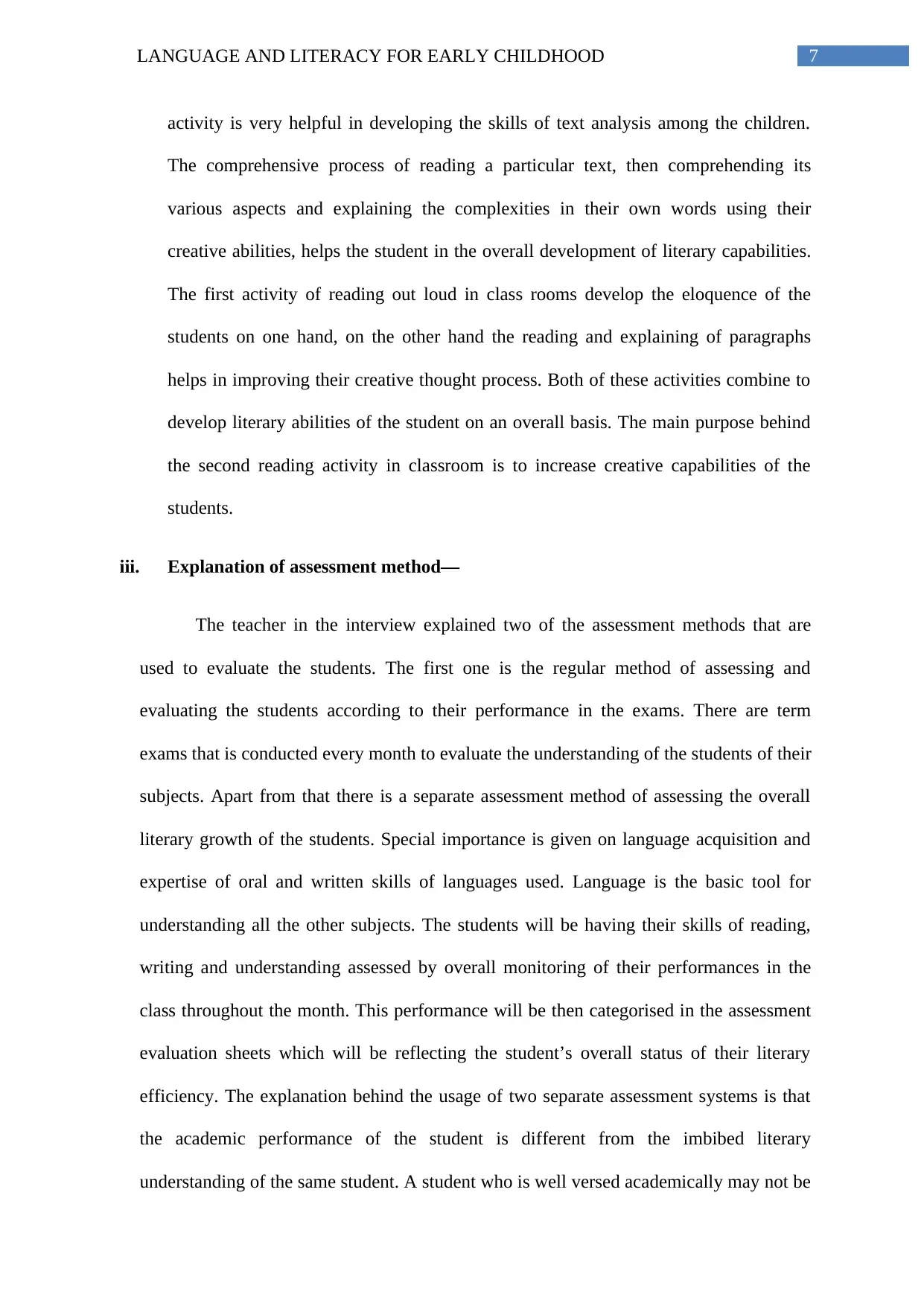
7LANGUAGE AND LITERACY FOR EARLY CHILDHOOD
activity is very helpful in developing the skills of text analysis among the children.
The comprehensive process of reading a particular text, then comprehending its
various aspects and explaining the complexities in their own words using their
creative abilities, helps the student in the overall development of literary capabilities.
The first activity of reading out loud in class rooms develop the eloquence of the
students on one hand, on the other hand the reading and explaining of paragraphs
helps in improving their creative thought process. Both of these activities combine to
develop literary abilities of the student on an overall basis. The main purpose behind
the second reading activity in classroom is to increase creative capabilities of the
students.
iii. Explanation of assessment method—
The teacher in the interview explained two of the assessment methods that are
used to evaluate the students. The first one is the regular method of assessing and
evaluating the students according to their performance in the exams. There are term
exams that is conducted every month to evaluate the understanding of the students of their
subjects. Apart from that there is a separate assessment method of assessing the overall
literary growth of the students. Special importance is given on language acquisition and
expertise of oral and written skills of languages used. Language is the basic tool for
understanding all the other subjects. The students will be having their skills of reading,
writing and understanding assessed by overall monitoring of their performances in the
class throughout the month. This performance will be then categorised in the assessment
evaluation sheets which will be reflecting the student’s overall status of their literary
efficiency. The explanation behind the usage of two separate assessment systems is that
the academic performance of the student is different from the imbibed literary
understanding of the same student. A student who is well versed academically may not be
activity is very helpful in developing the skills of text analysis among the children.
The comprehensive process of reading a particular text, then comprehending its
various aspects and explaining the complexities in their own words using their
creative abilities, helps the student in the overall development of literary capabilities.
The first activity of reading out loud in class rooms develop the eloquence of the
students on one hand, on the other hand the reading and explaining of paragraphs
helps in improving their creative thought process. Both of these activities combine to
develop literary abilities of the student on an overall basis. The main purpose behind
the second reading activity in classroom is to increase creative capabilities of the
students.
iii. Explanation of assessment method—
The teacher in the interview explained two of the assessment methods that are
used to evaluate the students. The first one is the regular method of assessing and
evaluating the students according to their performance in the exams. There are term
exams that is conducted every month to evaluate the understanding of the students of their
subjects. Apart from that there is a separate assessment method of assessing the overall
literary growth of the students. Special importance is given on language acquisition and
expertise of oral and written skills of languages used. Language is the basic tool for
understanding all the other subjects. The students will be having their skills of reading,
writing and understanding assessed by overall monitoring of their performances in the
class throughout the month. This performance will be then categorised in the assessment
evaluation sheets which will be reflecting the student’s overall status of their literary
efficiency. The explanation behind the usage of two separate assessment systems is that
the academic performance of the student is different from the imbibed literary
understanding of the same student. A student who is well versed academically may not be
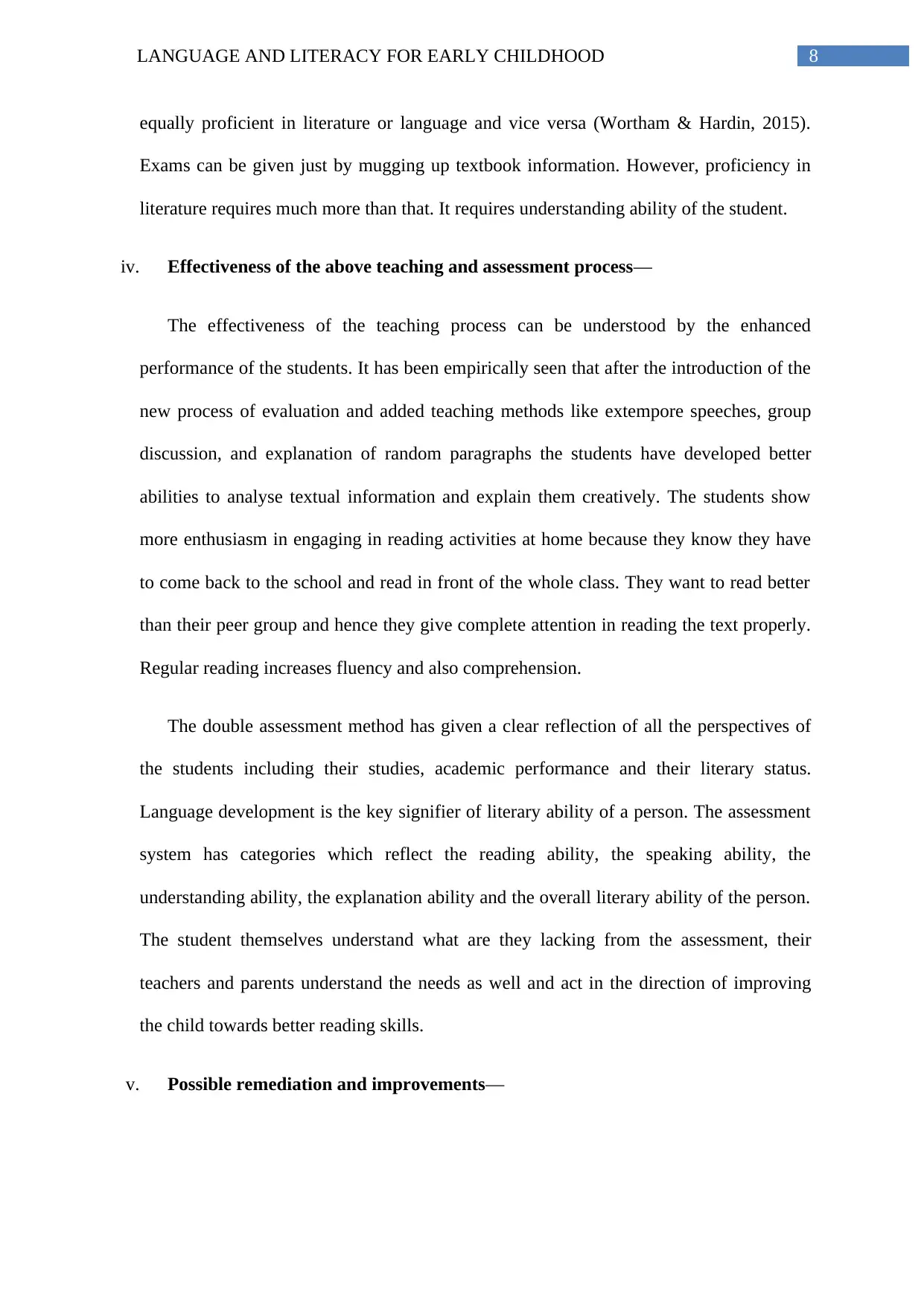
8LANGUAGE AND LITERACY FOR EARLY CHILDHOOD
equally proficient in literature or language and vice versa (Wortham & Hardin, 2015).
Exams can be given just by mugging up textbook information. However, proficiency in
literature requires much more than that. It requires understanding ability of the student.
iv. Effectiveness of the above teaching and assessment process—
The effectiveness of the teaching process can be understood by the enhanced
performance of the students. It has been empirically seen that after the introduction of the
new process of evaluation and added teaching methods like extempore speeches, group
discussion, and explanation of random paragraphs the students have developed better
abilities to analyse textual information and explain them creatively. The students show
more enthusiasm in engaging in reading activities at home because they know they have
to come back to the school and read in front of the whole class. They want to read better
than their peer group and hence they give complete attention in reading the text properly.
Regular reading increases fluency and also comprehension.
The double assessment method has given a clear reflection of all the perspectives of
the students including their studies, academic performance and their literary status.
Language development is the key signifier of literary ability of a person. The assessment
system has categories which reflect the reading ability, the speaking ability, the
understanding ability, the explanation ability and the overall literary ability of the person.
The student themselves understand what are they lacking from the assessment, their
teachers and parents understand the needs as well and act in the direction of improving
the child towards better reading skills.
v. Possible remediation and improvements—
equally proficient in literature or language and vice versa (Wortham & Hardin, 2015).
Exams can be given just by mugging up textbook information. However, proficiency in
literature requires much more than that. It requires understanding ability of the student.
iv. Effectiveness of the above teaching and assessment process—
The effectiveness of the teaching process can be understood by the enhanced
performance of the students. It has been empirically seen that after the introduction of the
new process of evaluation and added teaching methods like extempore speeches, group
discussion, and explanation of random paragraphs the students have developed better
abilities to analyse textual information and explain them creatively. The students show
more enthusiasm in engaging in reading activities at home because they know they have
to come back to the school and read in front of the whole class. They want to read better
than their peer group and hence they give complete attention in reading the text properly.
Regular reading increases fluency and also comprehension.
The double assessment method has given a clear reflection of all the perspectives of
the students including their studies, academic performance and their literary status.
Language development is the key signifier of literary ability of a person. The assessment
system has categories which reflect the reading ability, the speaking ability, the
understanding ability, the explanation ability and the overall literary ability of the person.
The student themselves understand what are they lacking from the assessment, their
teachers and parents understand the needs as well and act in the direction of improving
the child towards better reading skills.
v. Possible remediation and improvements—
⊘ This is a preview!⊘
Do you want full access?
Subscribe today to unlock all pages.

Trusted by 1+ million students worldwide
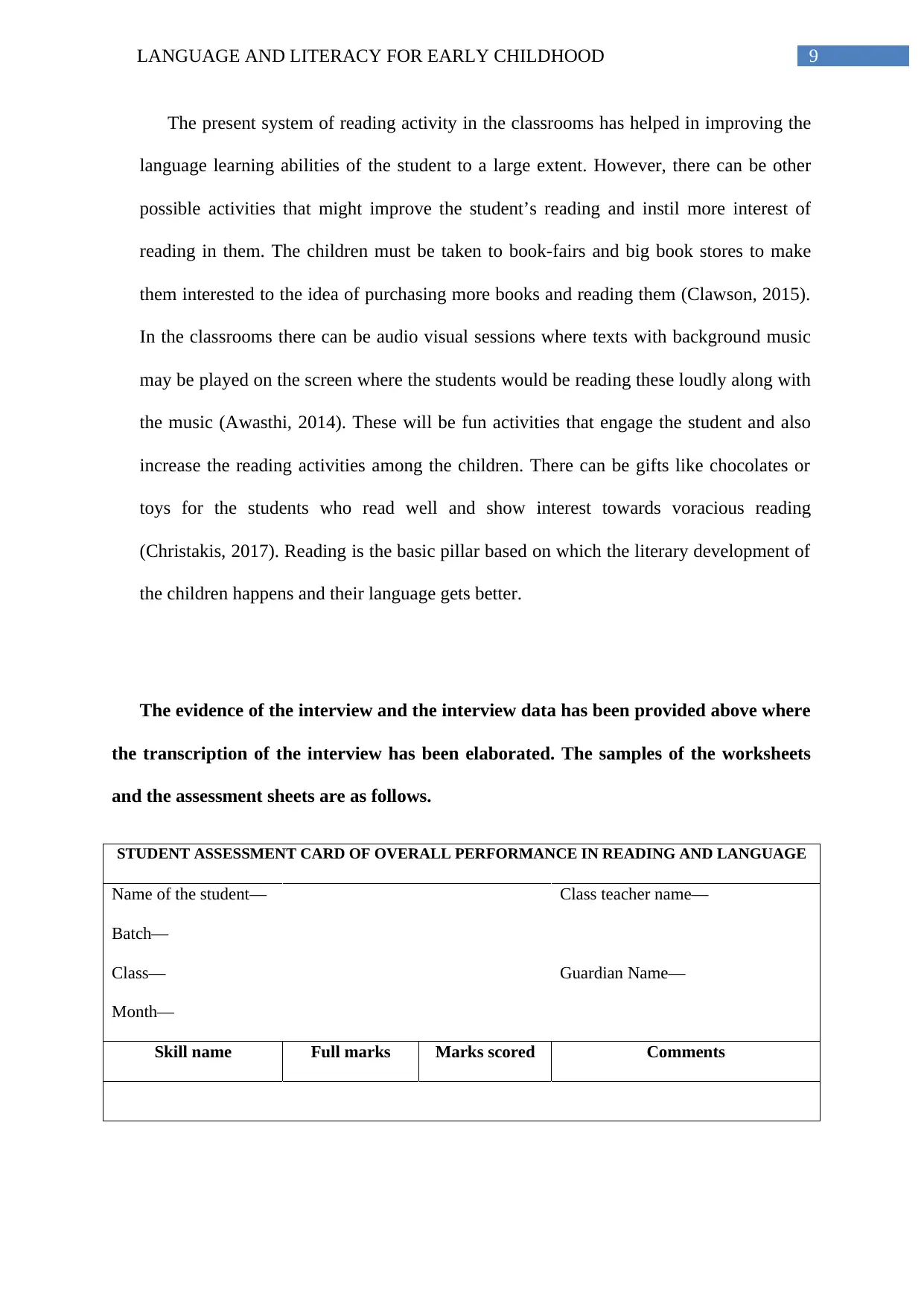
9LANGUAGE AND LITERACY FOR EARLY CHILDHOOD
The present system of reading activity in the classrooms has helped in improving the
language learning abilities of the student to a large extent. However, there can be other
possible activities that might improve the student’s reading and instil more interest of
reading in them. The children must be taken to book-fairs and big book stores to make
them interested to the idea of purchasing more books and reading them (Clawson, 2015).
In the classrooms there can be audio visual sessions where texts with background music
may be played on the screen where the students would be reading these loudly along with
the music (Awasthi, 2014). These will be fun activities that engage the student and also
increase the reading activities among the children. There can be gifts like chocolates or
toys for the students who read well and show interest towards voracious reading
(Christakis, 2017). Reading is the basic pillar based on which the literary development of
the children happens and their language gets better.
The evidence of the interview and the interview data has been provided above where
the transcription of the interview has been elaborated. The samples of the worksheets
and the assessment sheets are as follows.
STUDENT ASSESSMENT CARD OF OVERALL PERFORMANCE IN READING AND LANGUAGE
Name of the student—
Batch—
Class—
Month—
Class teacher name—
Guardian Name—
Skill name Full marks Marks scored Comments
The present system of reading activity in the classrooms has helped in improving the
language learning abilities of the student to a large extent. However, there can be other
possible activities that might improve the student’s reading and instil more interest of
reading in them. The children must be taken to book-fairs and big book stores to make
them interested to the idea of purchasing more books and reading them (Clawson, 2015).
In the classrooms there can be audio visual sessions where texts with background music
may be played on the screen where the students would be reading these loudly along with
the music (Awasthi, 2014). These will be fun activities that engage the student and also
increase the reading activities among the children. There can be gifts like chocolates or
toys for the students who read well and show interest towards voracious reading
(Christakis, 2017). Reading is the basic pillar based on which the literary development of
the children happens and their language gets better.
The evidence of the interview and the interview data has been provided above where
the transcription of the interview has been elaborated. The samples of the worksheets
and the assessment sheets are as follows.
STUDENT ASSESSMENT CARD OF OVERALL PERFORMANCE IN READING AND LANGUAGE
Name of the student—
Batch—
Class—
Month—
Class teacher name—
Guardian Name—
Skill name Full marks Marks scored Comments
Paraphrase This Document
Need a fresh take? Get an instant paraphrase of this document with our AI Paraphraser
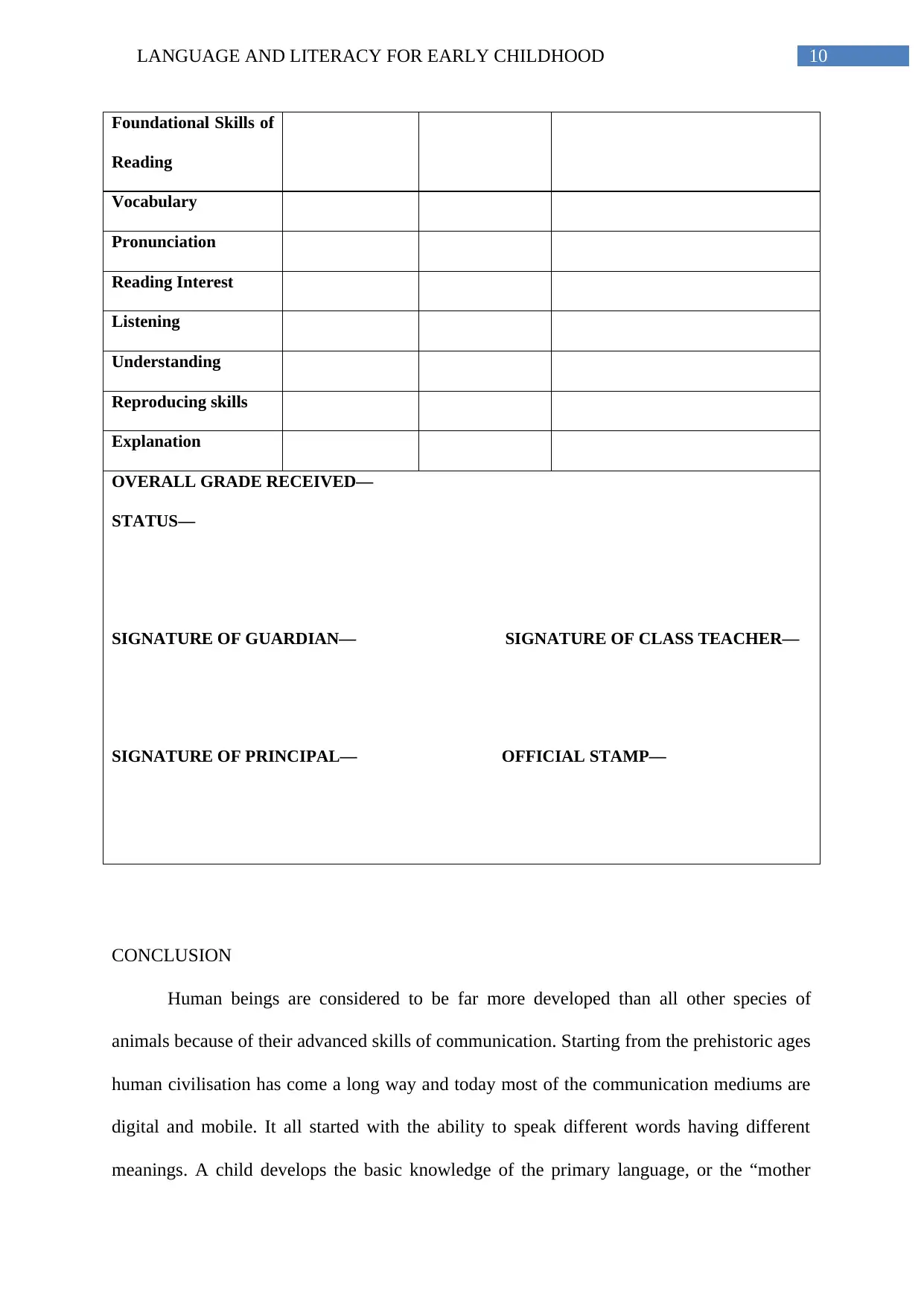
10LANGUAGE AND LITERACY FOR EARLY CHILDHOOD
Foundational Skills of
Reading
Vocabulary
Pronunciation
Reading Interest
Listening
Understanding
Reproducing skills
Explanation
OVERALL GRADE RECEIVED—
STATUS—
SIGNATURE OF GUARDIAN— SIGNATURE OF CLASS TEACHER—
SIGNATURE OF PRINCIPAL— OFFICIAL STAMP—
CONCLUSION
Human beings are considered to be far more developed than all other species of
animals because of their advanced skills of communication. Starting from the prehistoric ages
human civilisation has come a long way and today most of the communication mediums are
digital and mobile. It all started with the ability to speak different words having different
meanings. A child develops the basic knowledge of the primary language, or the “mother
Foundational Skills of
Reading
Vocabulary
Pronunciation
Reading Interest
Listening
Understanding
Reproducing skills
Explanation
OVERALL GRADE RECEIVED—
STATUS—
SIGNATURE OF GUARDIAN— SIGNATURE OF CLASS TEACHER—
SIGNATURE OF PRINCIPAL— OFFICIAL STAMP—
CONCLUSION
Human beings are considered to be far more developed than all other species of
animals because of their advanced skills of communication. Starting from the prehistoric ages
human civilisation has come a long way and today most of the communication mediums are
digital and mobile. It all started with the ability to speak different words having different
meanings. A child develops the basic knowledge of the primary language, or the “mother
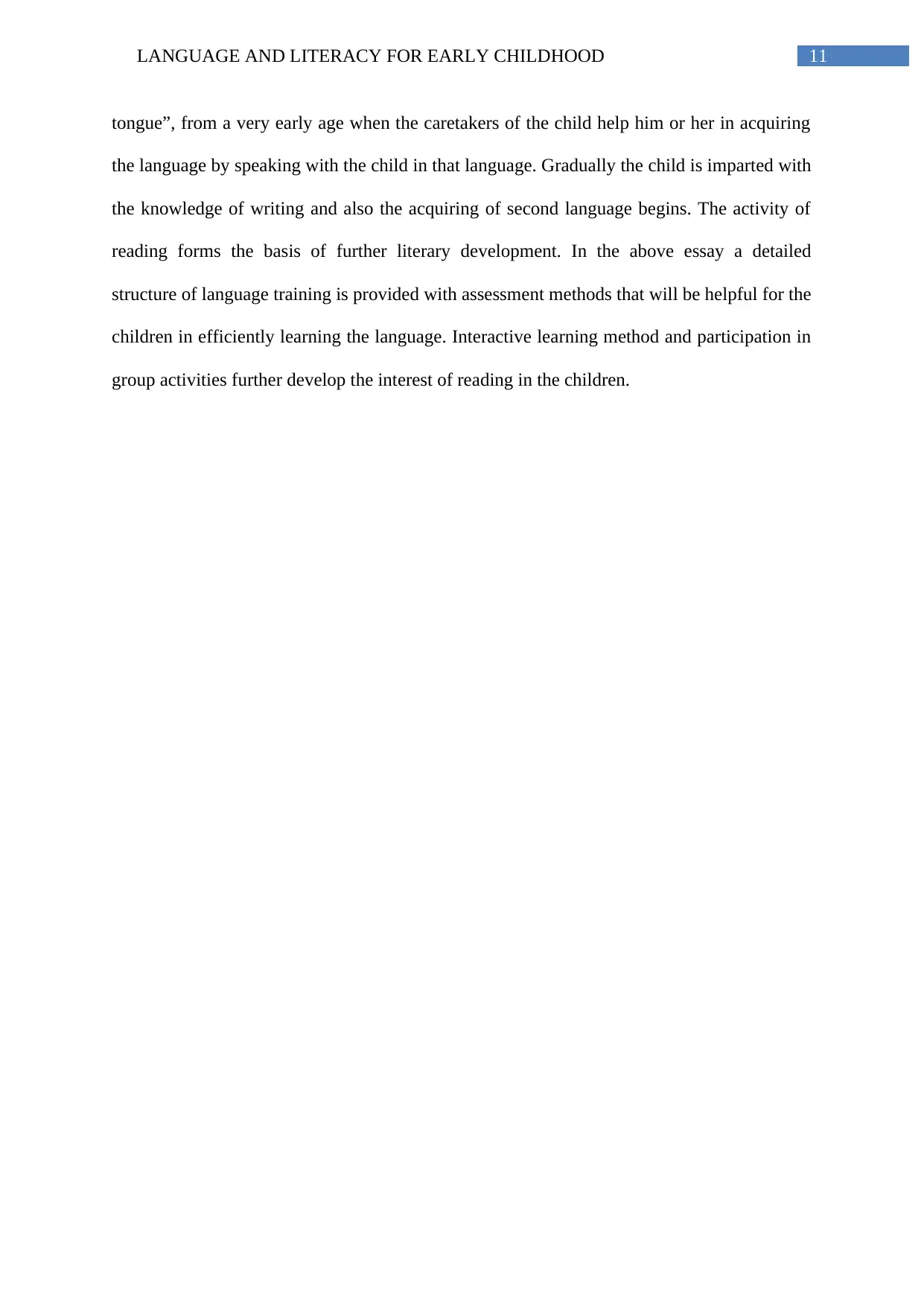
11LANGUAGE AND LITERACY FOR EARLY CHILDHOOD
tongue”, from a very early age when the caretakers of the child help him or her in acquiring
the language by speaking with the child in that language. Gradually the child is imparted with
the knowledge of writing and also the acquiring of second language begins. The activity of
reading forms the basis of further literary development. In the above essay a detailed
structure of language training is provided with assessment methods that will be helpful for the
children in efficiently learning the language. Interactive learning method and participation in
group activities further develop the interest of reading in the children.
tongue”, from a very early age when the caretakers of the child help him or her in acquiring
the language by speaking with the child in that language. Gradually the child is imparted with
the knowledge of writing and also the acquiring of second language begins. The activity of
reading forms the basis of further literary development. In the above essay a detailed
structure of language training is provided with assessment methods that will be helpful for the
children in efficiently learning the language. Interactive learning method and participation in
group activities further develop the interest of reading in the children.
⊘ This is a preview!⊘
Do you want full access?
Subscribe today to unlock all pages.

Trusted by 1+ million students worldwide
1 out of 13
Related Documents
Your All-in-One AI-Powered Toolkit for Academic Success.
+13062052269
info@desklib.com
Available 24*7 on WhatsApp / Email
![[object Object]](/_next/static/media/star-bottom.7253800d.svg)
Unlock your academic potential
Copyright © 2020–2026 A2Z Services. All Rights Reserved. Developed and managed by ZUCOL.





